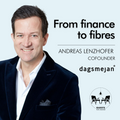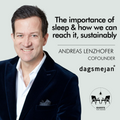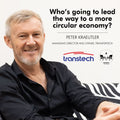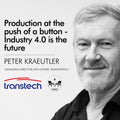COLLABORATION: THE CURRENT SPEARHEAD FOR CIRCULARITY

Collaboration: the current spearhead for circularity
GUESTS FOR CHANGE with Asheen Phansey
PART 2
Within the Guests for Change series, thought leaders, pioneers, visionaries, and game-changers share their insights into the world of sustainability and circularity. THE GUESTLIST was first introduced to Asheen Phansey as a part of Eleven Radius (previously the Circular Fashion Pledge), with our CEO, Anton Schumann, showcasing the Cashmere Spa initiative as a practical approach to circularity.
Previously touching on how corporate players can become more circular and conscious in their approaches to business, Asheen further explored the factors that come into play within the journey towards a more circular future with Guests for Change.
“Sustainability and circularity always have a positive return on investment,” shares Asheen. “It’s just a matter of how you define “return” and “investment.”
“Sustainability and circularity always have a positive return on investment,” shares Asheen. “It’s just a matter of how you define “return” and “investment.” If you define it only financially, it may be negative only in the short-term. But, if you define it as the whole collective of financial, social and environmental aspects, then it’s always positive.” Indeed, when looking at the long-term profitability of circularity, some costs will go up while others may come down - as things like a reduction of waste or energy comes into play as you improve your practices. However, the key with a circular business approach lies in how we relate to our customers.
Many of the more linear-approach business-models that currently exist, keep interaction with their customers to a minimum. However, when creating a circular business, the message to the customers is a strong one. It imbues a far deeper sense of responsibility and ownership that overlaps in that space between values, humanity, and business. Asheen shares that, “You’re telling your customer that whatever it is that they’ve bought from you, you care about. And you want to help them to figure out what to do with it afterwards or what to do with it after you own it. You are creating a deeper customer relationship.”
when creating a circular business, the message to the customers is a strong one. It imbues a far deeper sense of responsibility and ownership that overlaps in that space between values, humanity, and business.

Using THE GUESTLIST’s Cashmere Spa as an example of this, Asheen shared, “It may cost a little bit more to service these garments over the course of their life, to extend the product life for the customer. But, what it costs in upfront labor and materials is being returned tenfold by connecting with customers, sharing the brand's values with them, and connecting with them on a continuing basis, nourishing that relationship.”
“It becomes a matter of shifting from a model of throwing stuff out into the world, to really caring about the things that we put out into the world, and showing customers that we care about them. That is incredibly valuable and incredibly profitable,” he says.
“It becomes a matter of shifting from a model of throwing stuff out into the world, to really caring about the things that we put out into the world, and showing customers that we care about them. That is incredibly valuable and incredibly profitable.”
What factors into this is the understanding and acknowledgement that we are all in a period of testing and trials. Not a single brand or business can claim to be entirely circular or sustainable in the modern day world - as this would imply a complete system overhaul. “We can’t say that we are promoting the best practices,” says Asheen, “Because no one knows what those practices are yet. We can only say that we are promoting practices that are great, but some of them we’re trying, and they might not work. And that’s absolutely fine - because we’re re-inventing the entire global economy from a linear model!"
"So, what we see is many brands and companies doing different things - giving them a try and then seeing if customers are interested in them, and if other brands are interested in them. And if it’s both, then perhaps there is the opportunity to create this hybrid model where I combine being a brand - producing something that I really care about that hopefully other people are interested in too - with being a service which I hope is going to move circularity forward and move the industry forward. This is something that brings value to consumers and to other brands as well - in taking action to do that.” Such is the case with THE GUESTLIST and the Cashmere Spa - which has been lauded as an excellent way of putting circularity into action in an accessible and easy way.

Image via THE GUESTLIST
“The aim of things at the moment is “Let’s take what we do and spread it to other circular brands” he says. “It’s not a matter of competing, it’s a matter of collaborating.”
This is put into practice as the Cashmere Spa partners with brands who are already producing high-quality, ethical fashion. Such brands are able to offer the service of the Cashmere Spa to their clients, who can send in their pieces to be sanitized, repaired, rejuvenated and returned to them - extending their garment’s longevity. It even incorporates a wool-recycling initiative, where the yarns from pieces that are beyond repair are sent to spinners in Italy where they are re-spun and used to create more pieces - further reducing their carbon-footprint.
Collaborative approaches are even found at higher levels. Asheen notes the difference between the Kyoto Protocol and the Paris Agreement of 2015. “It was a key moment,” he mentions. “What made it different from the Kyoto Protocol (which said that “Everyone’s going to reduce. It’s legally binding. This is how we are going to do it,”) was that the Paris Accord was more along the lines of “We want you to tell us what is your individual, national contribution to climate and to the climate crisis?”"
"As examples, the US said that they would reduce coal-fired electricity. India outlined how rural electrification was a huge barrier for them for social improvement. As such, they would keep up with their emissions to focus on the social improvements, which would peak in terms of emissions, but following that they would focus on reducing their impact. China said that they would create the world’s biggest cap and trade program. Every nation had its own, different, individual contribution. And, as a whole, it was looked at that collectively, these would add to a 3.5- to 4-degree temperature rise. And from there, there was the notion of getting together again in a few years, ratcheting it up, and being even more ambitious. It became a way of looking at each individual country’s unique way of contributing.”
“While there is much criticism of the Paris agreement, it is a recognition that we are all in this crisis together. And it is a mechanism, a process and a global commitment to a better future. This needs to be celebrated as such.”
“While there is much criticism of the Paris agreement," he says, "It is a recognition that we are all in this crisis together. And it is a mechanism, a process and a global commitment to a better future. This needs to be celebrated as such.” At the basis of the journey towards circularity, we need to be looking at how our impacts affect everyone.Indeed, something released into the atmosphere in one area will have an impact on the atmosphere as a whole, not just the atmosphere in that area.
Following this understanding is THE GUESTLIST’s foundation that we are all Guests to this Earth, and while our time here may be limited, our impacts are not. Collaboration therefore, is vitally important for the benefit of all. Watch the second part of the Guests for Change interview below for further insights into this matter.








Leave a comment